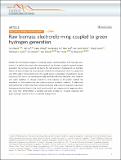Raw biomass electroreforming coupled to green hydrogen generation
Author(s)
Zhao, Hu; Lu, Dan; Wang, Jiarui; Tu, Wenguang; Wu, Dan; Koh, See Wee; Gao, Pingqi; Xu, Zhichuan J; Deng, Sili; Zhou, Yan; You, Bo; Li, Hong; ... Show more Show less
DownloadPublished version (6.535Mb)
Publisher with Creative Commons License
Publisher with Creative Commons License
Creative Commons Attribution
Terms of use
Metadata
Show full item recordAbstract
<jats:title>Abstract</jats:title><jats:p>Despite the tremendous progress of coupling organic electrooxidation with hydrogen generation in a hybrid electrolysis, electroreforming of raw biomass coupled to green hydrogen generation has not been reported yet due to the rigid polymeric structures of raw biomass. Herein, we electrooxidize the most abundant natural amino biopolymer chitin to acetate with over 90% yield in hybrid electrolysis. The overall energy consumption of electrolysis can be reduced by 15% due to the thermodynamically and kinetically more favorable chitin oxidation over water oxidation. In obvious contrast to small organics as the anodic reactant, the abundance of chitin endows the new oxidation reaction excellent scalability. A solar-driven electroreforming of chitin and chitin-containing shrimp shell waste is coupled to safe green hydrogen production thanks to the liquid anodic product and suppression of oxygen evolution. Our work thus demonstrates a scalable and safe process for resource upcycling and green hydrogen production for a sustainable energy future.</jats:p>
Date issued
2021Department
Massachusetts Institute of Technology. Department of Mechanical EngineeringJournal
Nature Communications
Publisher
Springer Science and Business Media LLC
Citation
Zhao, Hu, Lu, Dan, Wang, Jiarui, Tu, Wenguang, Wu, Dan et al. 2021. "Raw biomass electroreforming coupled to green hydrogen generation." Nature Communications, 12 (1).
Version: Final published version